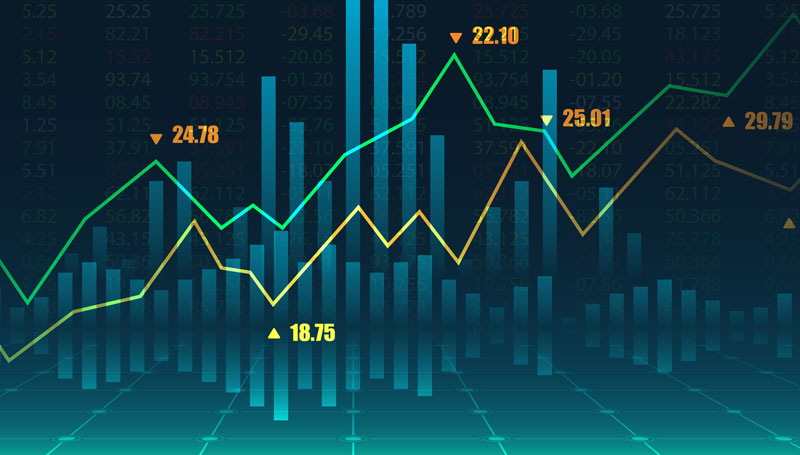

11.03.2020 – Daily Report. The stock market in Frankfurt is taking action again, but only moderately. After the failed recovery from the previous day, prices are only rising a little. The Dow Jones had risen by almost 1,200 the previous evening. But US futures are crumbling again.
Slight gain on the Frankfurt Stock Exchange
It almost seems as if too many long investors burned their fingers yesterday. By noon the DAX had risen by a moderate 1.6 percent to 10,639 points. And this after mega gains on Wall Street. These, however, are only achieved in late trading – and so on Tuesday the first courageous investors on the German stock exchange walked into a bull trap.
The US futures fell by a good 2 percent on Wednesday noon. Brokers pointed to the lack of details in the aid package promised by US President Donald Trump.
Losses in Asia
As a result, brokers in Asia also held back. The Chinese CSI-300 lost 1.3 percent to 4,028 points in the morning. In Tokyo, the Nikkei fell by 2.3 percent to 19,416 points.
State money from the EU
Meanwhile, Europe is discussing a stimulus. The European Union wants to pump 25 billion euros into the economy to counter the worst effects of the Covid 19 epidemic. The money is to come from the structural funds and flow quickly.
Surprising interest rate cut in London
England has also introduced its own measures. First of all, the British central bank lowered the key interest rate by 0.50 points to 0.25 percent in a special session due to corona. This was the first interest rate cut since August 2016, and the Pound came under pressure only briefly: GBPUSD fell from 1.2936 to 1.2847 and then rose again to 1.2939. The Bank of England also plans to launch a credit program for small businesses in the coming 12 months.
Strong recovery in New York
The evening before, prices had risen sharply following the announcement of a $300 billion US economic stimulus package by the White House. The major indices closed at their daily high. The Dow Jones Industrial fizzled up 4.9 percent to 25,018 positions. That was a whopping 1,167 points. The S&P 500 also climbed 4.9 percent to 2,882 digits. This was the best daily performance since December 26, 2018, and the Nasdaq Composite gained 5 percent to 8,344.
The rebound was not really unusual: According to MarketWatch, the Bespoke Investment Group announced that in the ten cases since 1952 in which the S&P 500 had fallen by at least 5 percent on a Monday, Tuesday had brought a recovery averaging 4.2 percent.
Oil market between hope and fear
Meanwhile, investors are waiting for movement in the oil war between Russia and Saudi Arabia. Prices of WTI and Brent fluctuated sharply and, after an overnight recovery, fell by a good 4 percent. Moscow has probably not yet completely dismissed the possibility of a concession with OPEC, the market said. Reuters reported with reference to insiders that today there is a meeting between managers of Russian oil companies and the ministry.
Yesterday, however, Russia’s Energy Minister Alexander Novak told the TV station Rossia24 that the door between OPEC and Russia had not yet been closed. However, he added that his country could increase production by 200,000 to 300,000 barrels in the short term. However, this is only small-calibre compared to the bullets in the Saudi arsenal: Saudi Aramco had announced yesterday in an official stock exchange release that it would increase production to 12.3 million barrels per day from April. The state-owned company had last pumped an average of 9.7 million barrels from the desert floor.
This is what the day brings
The calendar of events on Wednesday brings some interesting events, you can find the overview as always here: Market Mover
For example, at 13.30, US consumer prices for February are reported.
The same for hourly wages/real income.
At 15.30 the weekly oil report comes in.
And at 19.00 U.S. Treasury figures.
The Bernstein Bank wishes successful trades!
Important Notes on This Publication:
The content of this publication is for general information purposes only. In this context, it is neither an individual investment recommendation or advice nor an offer to purchase or sell securities or other financial products. The content in question and all the information contained therein do not in any way replace individual investor- or investment-oriented advice. No reliable forecast or indication for the future is possible with respect to any presentation or information on the present or past performance of the relevant underlying assets. All information and data presented in this publication are based on reliable sources. However, Bernstein Bank does not guarantee that the information and data contained in this publication is up-to-date, correct and complete. Securities traded on the financial markets are subject to price fluctuations. A contract for difference (CFD) is also a financial instrument with leverage effect. Against this backdrop, CFD trading involves a high risk up to the point of total loss and may not be suitable for all investors. Therefore, make sure that you have fully understood all the correlating risks. If necessary, ask for independent advice.
